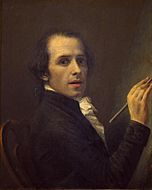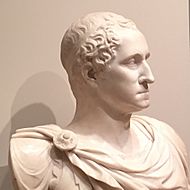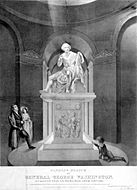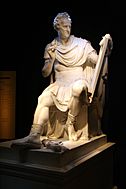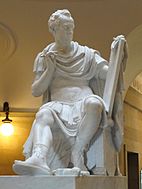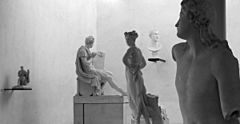George Washington (Canova) facts for kids
Quick facts for kids Lua error in Module:Wikidata at line 560: attempt to index field 'wikibase' (a nil value). |
|
|---|---|
| Italian: Giorgio Washington | |
| Lua error in Module:WikidataIB at line 168: attempt to index field 'wikibase' (a nil value).
Script error: The function "getImageLegend" does not exist.
|
|
| Lua error in Module:Infobox_mapframe at line 185: attempt to index field 'wikibase' (a nil value). | |
| Artist | Script error: The function "getPreferredValue" does not exist. |
| Year | Lua error in Module:Wd at line 1575: attempt to index field 'wikibase' (a nil value). |
| Medium | Script error: The function "getPreferredValue" does not exist. |
| Movement | Script error: The function "getPreferredValue" does not exist. |
| Subject | Script error: The function "getPreferredValue" does not exist. |
| Dimensions | × × × |
| Designation | Script error: The function "getPreferredValue" does not exist. |
| Location | {{#Property:P17|from= }} Lua error in Module:EditAtWikidata at line 29: attempt to index field 'wikibase' (a nil value). |
| Coordinates | Lua error in Module:Coordinates at line 614: attempt to index field 'wikibase' (a nil value). |
| Owner | Script error: The function "getPreferredValue" does not exist. |
| Commissioned by | Script error: The function "getPreferredValue" does not exist. |
| Collection | Script error: The function "getPreferredValue" does not exist. |
| Accession No. | Script error: The function "getPreferredValue" does not exist. |
| Preceded by | Script error: The function "getPreferredValue" does not exist. |
| Followed by | Script error: The function "getPreferredValue" does not exist. |
George Washington was a famous marble statue of America's first president, George Washington. It was made by a talented Italian sculptor named Antonio Canova, who worked in a classical style. The statue showed Washington looking like an ancient Roman general. The state of North Carolina asked Canova to create it in 1815, and he finished it in 1820. It was placed in the rotunda of the North Carolina State House on December 24, 1821. Sadly, the building and the statue were both destroyed in a big fire on June 21, 1831. This was the only artwork Canova ever made for the United States.
Contents
The Story of the Statue
In December 1815, leaders in North Carolina decided they wanted a full-size statue of George Washington. The governor, William Miller, asked for help from Thomas Jefferson, who used to be president. Jefferson suggested that Antonio Canova should be the sculptor. He also recommended that Canova use a marble bust of Washington made by Giuseppe Ceracchi as a model for the head.
Canova started working on the statue in his studio in Rome in 1817. He made several sketches and small models before finishing the full statue in 1820. Governor Miller asked for a United States Navy ship to bring the statue from Italy. The ship USS Columbus delivered it to Boston on July 22, 1821. The statue finally arrived in Raleigh, North Carolina, on December 24. It was placed in the state house during a special ceremony.
Canova never saw his statue installed in North Carolina because he passed away in Venice in 1822. In March 1825, a French hero named the Marquis de Lafayette saw the statue. He was very impressed, saying the statue looked much more like Washington than he had expected.
The Fire and What Happened Next
On June 21, 1831, workers were trying to make the state house roof safer from fire. They were soldering metal sheets onto the roof when they accidentally started a fire. The fire quickly spread, destroying both the state house and Canova's beautiful statue. People at the time called it an "Awful conflagration!"
Today, you can see a plaster copy of the statue at the North Carolina Museum of History. This copy was sent by the Italian government in 1910. A new marble copy was made by Romano Vio in 1970. This copy is now displayed in the rotunda of the North Carolina State Capitol. This new building stands in the same spot where the old state house was destroyed in 1831.
What the Statue Looked Like
The statue was made from white Carrara marble. Washington was shown seated and dressed in ancient Roman armor. He held a tablet in his left hand and a quill (a type of pen) in his right hand. This showed him as a modern Cincinnatus, a Roman hero who returned to his farm after serving his country. At Washington's feet were a sword and a military baton.
The base of the statue had this message carved into it:
|
Giorgio Washington |
George Washington |
The statue stood on a separate pedestal, which was made by Canova's student, Raimondo Trentanove. Trentanove carved four bas-reliefs (pictures that stick out from the surface) into the white marble of the pedestal. Each carving showed an important moment from Washington's life.
The first carving showed the surrender of British General Charles Cornwallis at Yorktown, with Washington celebrating his victory. The second scene showed Washington resigning as commander-in-chief of the Continental Army to Congress. The third carving showed him being elected as President of the United States. The last scene showed him back at his farm at Mount Vernon with a plow, like Cincinnatus returning to his private life after serving his country.
Recent Exhibitions
From May to September 2018, the Frick Collection in New York City held an exhibition called Canova's George Washington. This show displayed several of the small models Canova used to create the statue, including a full-size plaster model. This model was borrowed from the Museo Canova in Possagno, Italy. The exhibition then moved to the Museo Canova, where it was on display from November 2018 to April 2019.
Images for kids
-
Canova, self-portrait, 1792
-
George Washington, a plaster copy on display at the North Carolina Museum of History
-
George Washington, a marble copy by Romano Vio in the North Carolina State Capitol


